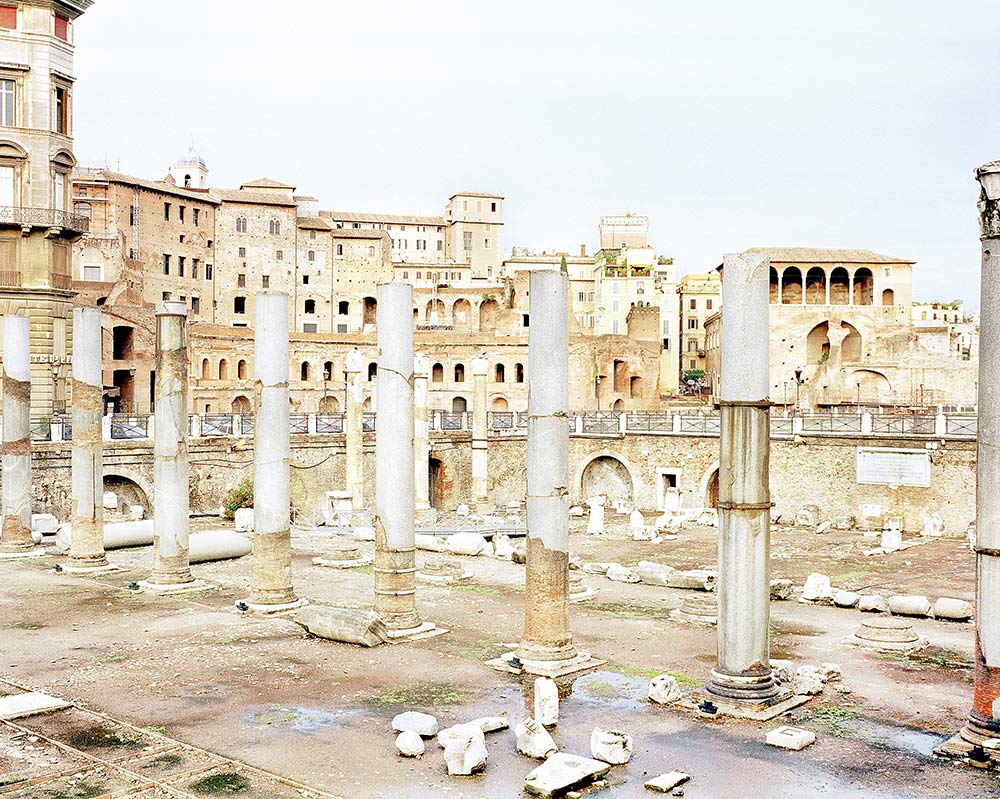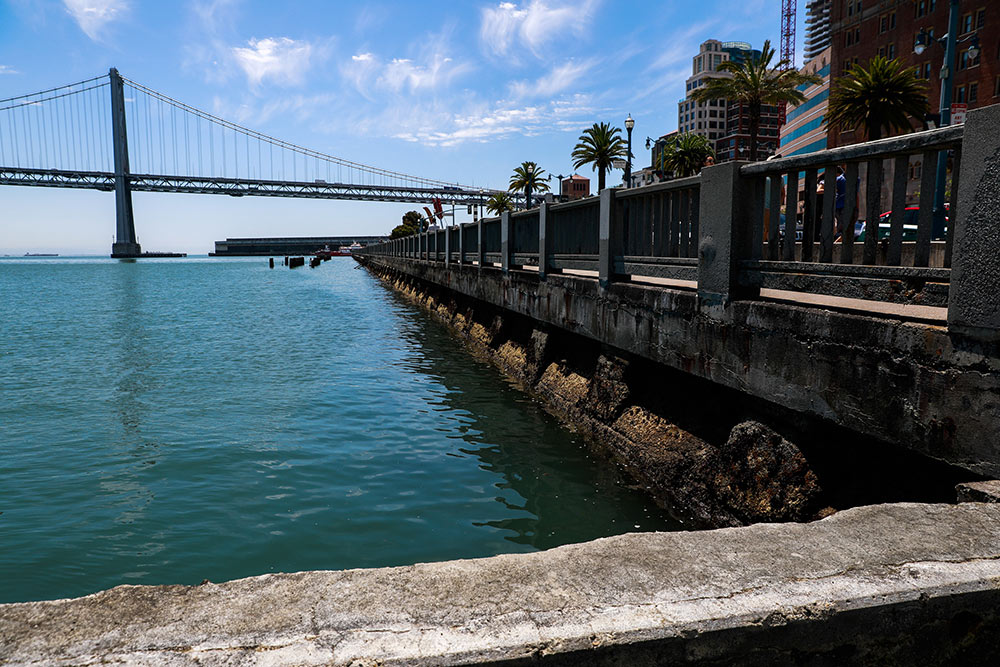在图拉真皇帝统治下的罗马帝国,每周都是“基建周”。当时(公元98-117年)的罗马欣欣向荣,图拉真主持兴建了大量公共工程项目:新的道路桥梁、沟渠、公共浴场,还在罗马城西部奥斯蒂亚海岸建了一个大型海港。(图拉真的前任奥古斯都也十分勤勉。)
你如果去过意大利,一定会惊叹于这些经历了历史风霜的工程壮举。
其中一个坐落在罗马市中心,多年来一直令历史学家、工程师和地质学家着迷——图拉真市场。这个古老的市场位于罗马广场(Roman Forum)对面,宏伟坚固的建筑与罗马都城的全球贸易中心地位相得益彰。市场入口的拱形混凝土走廊建于1900年前。即便你不是混凝土建筑爱好者,这座建筑开创性的设计和耐久性也仍然值得欣赏。它经受住了地震、烟雾、劫掠和熙熙攘攘的游客,而建筑本身却没有一点钢筋支撑。

犹他大学(University of Utah)的地质与地球物理学系教授玛丽·杰克逊说,那个年代的混凝土港口甚至更令人印象深刻。它们至今仍然完好无损。相较之下,20世纪建造的许多滨水项目已经摇摇欲坠。
“在旧金山的内河码头沿岸,能够看到建于20世纪50年代的防波堤上巨大的混凝土块剥落,钢筋裸露在混凝土表面。”她说。而过去十年的一系列影响学研究也发出了类似的哀叹。

20世纪90年代,被罗马帝国的建筑结构吸引,杰克逊前往意大利,研究这些建筑为什么可以经受住时间的考验,而现代混凝土建筑在寥寥几十年后就开始衰颓。(水泥和混凝土这两个词经常混用,但在建筑行业中,它们是有区别的:混凝土是水泥制成的最终产品。)
2013年,杰克逊所在的国际研究团队对超级稳定的罗马混凝土的原始配方进行了逆向工程研究。(剧透:是石灰和当地火山岩的混合物)这一发现震惊了水泥材料科学界的极客们,现在又让新一代建筑商兴奋不已,因为他们一直在寻找一种环保产品来替代现在普遍使用的波特兰水泥。
罗马人之后的建筑世界
波特兰水泥是19世纪的英国人发明的,发明者约瑟夫·阿斯普丁因为其与伸入英吉利海峡的波特兰岛上的石灰石相似而命名,已经成为世界各地城市和道路网络的基础建筑材料。优质的波特兰水泥价格低廉、用途广泛,但其使用寿命仅为几十年,保养问题令人头疼。而且这种材料的生产过程会对环境造成恶劣影响。波特兰水泥需要在高温窑炉中生产,过程中一种名为煅烧的化学反应会排放大量的温室气体。总的来说,全球大约8%的碳排放来自于波特兰水泥的生产。
另一方面,哪怕偶尔会遭遇野蛮侵略,罗马混凝土却能够经受几百年甚至几千年的岁月。这种混凝土更轻,而且几乎或完全不需要钢筋加固(视应用场景而定)。与此同时,生产罗马混凝土消耗的能源要少得多,产生的碳足迹也仅仅是波特兰水泥的一小部分。
多亏了像杰克逊这样的科学家团队,古罗马混凝土才得以重现。
杰克逊的研究成果在各大科学期刊上发表后,引起了美国能源部(U.S. Department of Energy)的注意。2019年,该部向杰克逊和她的研究团队提供了140万美元的能源部高级研究计划局(ARPA-E)拨款,用于研发现代版的罗马帝国建筑材料,并将其推向市场。
“我们需要创新,找到一种成本低又环保的替代材料。”她向《财富》杂志表示,“这就是我们所做的。”
杰克逊的团队与美国能源部研发实验室、萨凡纳河国家实验室(Savannah River National Laboratory)以及包括位于南卡罗莱纳的材料科学初创公司GlassWRX在内的多家建筑企业展开了合作。
“让罗马走进千家万户”
生产罗马混凝土显然有一个问题。它的配方中需要大量使用当地火山岩,一种被称为凝灰岩的岩石,鲜少存在于意大利半岛外的其他地方。古罗马人将石灰和当地的火山凝灰岩混合在一起,制成了混凝土,灌装进木制模板。他们还需要依赖大自然对最终产品进行加固。例如,当时的工程师们意识到,海水一旦接触未加工的水泥混合物,会立即引发“热的化学反应。石灰会被水化——将水分子融入其结构中——并与灰烬产生反应,将混合物整体黏合在一起”, 制造出十分坚固的建筑材料。杰克逊团队在2013年的论文中解释道。
对今天的建筑商来说,现有的罗马混凝土原材料根本无法满足全世界的建筑需求,尤其是在全球城市化加速的今天。(正如比尔·盖茨2019年在博客中所写:“到2060年,世界将新增2万亿平方英尺的建筑——相当于未来40年,每个月新建一座纽约市。”)
杰克逊的研发团队知道,如果他们不能从意大利农村开采这种材料,就必须在离家更近的地方开发一种同样好的替代品。“我们开始想,‘嘿,如果不能条条大道通罗马,就让我们把罗马带进千家万户吧。’”团队首席工程师、杰克逊在罗马混凝土项目上的合作伙伴托马斯·亚当斯说,“等到这个项目结束的时候,我们期望至少有一个(有望能有更多)示范项目完成了在罗马城外重现罗马混凝土的过程。”
这时GlassWRX加入了进来。该公司与杰克逊团队合作,开发了一种与古罗马混凝土差不多具有同等强度和耐久性的建筑材料。其原材料包括回收的玻璃。
GlassWRX材料的专业术语是“工程细胞岩浆”(ECM)。“有了ECM,我们能够生产更优质、更耐久、更环保的混凝土,可以造出能够更好地清洁空气和水处理的材料。”该公司在最近一次介绍中称。
第一代ECM还不能完全取代大多数建筑中的快干波特兰水泥。“但一旦工程师们拥有了这种材料,他们体内的黑客因子就开始起作用了。他们会想方设法争分夺秒尽快安装。”亚当斯还说,他可以预见将材料用于桥基台、挡土墙和防波堤的早期使用案例。
南卡州博福特市正在研究这种材料的使用。当地官员正在与GlassWRX讨论将ECM用于一个滨水项目的建设。杰克逊说,这将是古罗马以来第一个使用这种耐用材料的建筑项目,预计能够维持几个世纪,而且不需要水泥或钢筋支撑。“我们在现代从来没有见过这样的建筑,”她说。
GlassWRX的科学团队表示,保守地说,ECM可以维持200年。专家说,波特兰水泥,尤其是用于海洋环境中的水泥,使用25年到30年就会开始出现老化。
正是这种耐久性引起了美国能源部的注意。公众十分关注重建美国老旧基础设施系统的工程,而要以低碳的方式来完成目标,就需要寻找一种更环保、更耐用的波特兰水泥替代品。
“波特兰水泥可以说是工业文明世界的基石。”GlassWRX的首席执行官及联合创始人菲利普·加兰德说,“人类社会要进入智能城市和智能社会时代,可持续发展和应对气候变化是应有之义。这种新材料恰恰能够发挥用武之地,造福社会。”
帝国缔造者图拉真也许要面临竞争了。(财富中文网)
译者:Agatha
在图拉真皇帝统治下的罗马帝国,每周都是“基建周”。当时(公元98-117年)的罗马欣欣向荣,图拉真主持兴建了大量公共工程项目:新的道路桥梁、沟渠、公共浴场,还在罗马城西部奥斯蒂亚海岸建了一个大型海港。(图拉真的前任奥古斯都也十分勤勉。)
其中一个坐落在罗马市中心,多年来一直令历史学家、工程师和地质学家着迷——图拉真市场。这个古老的市场位于罗马广场(Roman Forum)对面,宏伟坚固的建筑与罗马都城的全球贸易中心地位相得益彰。市场入口的拱形混凝土走廊建于1900年前。即便你不是混凝土建筑爱好者,这座建筑开创性的设计和耐久性也仍然值得欣赏。它经受住了地震、烟雾、劫掠和熙熙攘攘的游客,而建筑本身却没有一点钢筋支撑。
罗马的图拉真市场是用罗马混凝土建造的,可以经历几百年甚至几千年不朽。
犹他大学(University of Utah)的地质与地球物理学系教授玛丽·杰克逊说,那个年代的混凝土港口甚至更令人印象深刻。它们至今仍然完好无损。相较之下,20世纪建造的许多滨水项目已经摇摇欲坠。
“在旧金山的内河码头沿岸,能够看到建于20世纪50年代的防波堤上巨大的混凝土块剥落,钢筋裸露在混凝土表面。”她说。而过去十年的一系列影响学研究也发出了类似的哀叹。
20世纪90年代,被罗马帝国的建筑结构吸引,杰克逊前往意大利,研究这些建筑为什么可以经受住时间的考验,而现代混凝土建筑在寥寥几十年后就开始衰颓。(水泥和混凝土这两个词经常混用,但在建筑行业中,它们是有区别的:混凝土是水泥制成的最终产品。)
2013年,杰克逊所在的国际研究团队对超级稳定的罗马混凝土的原始配方进行了逆向工程研究。(剧透:是石灰和当地火山岩的混合物)这一发现震惊了水泥材料科学界的极客们,现在又让新一代建筑商兴奋不已,因为他们一直在寻找一种环保产品来替代现在普遍使用的波特兰水泥。
罗马人之后的建筑世界
波特兰水泥是19世纪的英国人发明的,发明者约瑟夫·阿斯普丁因为其与伸入英吉利海峡的波特兰岛上的石灰石相似而命名,已经成为世界各地城市和道路网络的基础建筑材料。优质的波特兰水泥价格低廉、用途广泛,但其使用寿命仅为几十年,保养问题令人头疼。而且这种材料的生产过程会对环境造成恶劣影响。波特兰水泥需要在高温窑炉中生产,过程中一种名为煅烧的化学反应会排放大量的温室气体。总的来说,全球大约8%的碳排放来自于波特兰水泥的生产。
另一方面,哪怕偶尔会遭遇野蛮侵略,罗马混凝土却能够经受几百年甚至几千年的岁月。这种混凝土更轻,而且几乎或完全不需要钢筋加固(视应用场景而定)。与此同时,生产罗马混凝土消耗的能源要少得多,产生的碳足迹也仅仅是波特兰水泥的一小部分。
多亏了像杰克逊这样的科学家团队,古罗马混凝土才得以重现。
杰克逊的研究成果在各大科学期刊上发表后,引起了美国能源部(U.S. Department of Energy)的注意。2019年,该部向杰克逊和她的研究团队提供了140万美元的能源部高级研究计划局(ARPA-E)拨款,用于研发现代版的罗马帝国建筑材料,并将其推向市场。
“我们需要创新,找到一种成本低又环保的替代材料。”她向《财富》杂志表示,“这就是我们所做的。”
杰克逊的团队与美国能源部研发实验室、萨凡纳河国家实验室(Savannah River National Laboratory)以及包括位于南卡罗莱纳的材料科学初创公司GlassWRX在内的多家建筑企业展开了合作。
“让罗马走进千家万户”
生产罗马混凝土显然有一个问题。它的配方中需要大量使用当地火山岩,一种被称为凝灰岩的岩石,鲜少存在于意大利半岛外的其他地方。古罗马人将石灰和当地的火山凝灰岩混合在一起,制成了混凝土,灌装进木制模板。他们还需要依赖大自然对最终产品进行加固。例如,当时的工程师们意识到,海水一旦接触未加工的水泥混合物,会立即引发“热的化学反应。石灰会被水化——将水分子融入其结构中——并与灰烬产生反应,将混合物整体黏合在一起”, 制造出十分坚固的建筑材料。杰克逊团队在2013年的论文中解释道。
对今天的建筑商来说,现有的罗马混凝土原材料根本无法满足全世界的建筑需求,尤其是在全球城市化加速的今天。(正如比尔·盖茨2019年在博客中所写:“到2060年,世界将新增2万亿平方英尺的建筑——相当于未来40年,每个月新建一座纽约市。”)
杰克逊的研发团队知道,如果他们不能从意大利农村开采这种材料,就必须在离家更近的地方开发一种同样好的替代品。“我们开始想,‘嘿,如果不能条条大道通罗马,就让我们把罗马带进千家万户吧。’”团队首席工程师、杰克逊在罗马混凝土项目上的合作伙伴托马斯·亚当斯说,“等到这个项目结束的时候,我们期望至少有一个(有望能有更多)示范项目完成了在罗马城外重现罗马混凝土的过程。”
这时GlassWRX加入了进来。该公司与杰克逊团队合作,开发了一种与古罗马混凝土差不多具有同等强度和耐久性的建筑材料。其原材料包括回收的玻璃。
GlassWRX材料的专业术语是“工程细胞岩浆”(ECM)。“有了ECM,我们能够生产更优质、更耐久、更环保的混凝土,可以造出能够更好地清洁空气和水处理的材料。”该公司在最近一次介绍中称。
第一代ECM还不能完全取代大多数建筑中的快干波特兰水泥。“但一旦工程师们拥有了这种材料,他们体内的黑客因子就开始起作用了。他们会想方设法争分夺秒尽快安装。”亚当斯还说,他可以预见将材料用于桥基台、挡土墙和防波堤的早期使用案例。
南卡州博福特市正在研究这种材料的使用。当地官员正在与GlassWRX讨论将ECM用于一个滨水项目的建设。杰克逊说,这将是古罗马以来第一个使用这种耐用材料的建筑项目,预计能够维持几个世纪,而且不需要水泥或钢筋支撑。“我们在现代从来没有见过这样的建筑,”她说。
GlassWRX的科学团队表示,保守地说,ECM可以维持200年。专家说,波特兰水泥,尤其是用于海洋环境中的水泥,使用25年到30年就会开始出现老化。
正是这种耐久性引起了美国能源部的注意。公众十分关注重建美国老旧基础设施系统的工程,而要以低碳的方式来完成目标,就需要寻找一种更环保、更耐用的波特兰水泥替代品。
“波特兰水泥可以说是工业文明世界的基石。”GlassWRX的首席执行官及联合创始人菲利普·加兰德说,“人类社会要进入智能城市和智能社会时代,可持续发展和应对气候变化是应有之义。这种新材料恰恰能够发挥用武之地,造福社会。”
帝国缔造者图拉真也许要面临竞争了。(财富中文网)
译者:Agatha
In Emperor Trajan’s Rome, every week was “Infrastructure Week.” During his prosperous reign, from AD 98–117, Trajan commissioned massive public works projects: new bridges and roads, aqueducts, public baths, a vast maritime port on the Ostia coast just west of the city of Rome. (Trajan’s predecessor, Augustus, was no slouch either.)
If you’ve ever visited Italy, you’ve no doubt gawked at these long-standing feats of engineering.
One, in the center of Rome, has fascinated historians, engineers, and geologists for years: Trajan’s Market. Sitting across the street from the Roman Forum, the ancient marketplace is a grand, sturdy structure befitting any capital city with the ambitions of a global trading power. You enter through a vaulted concrete corridor built 1,900 years ago. Even if you’re no fan of concrete architecture, the edifice is still worth appreciating for its groundbreaking design and durability. It’s survived earthquakes, smog, marauding hordes, and throngs of tourists. And there’s not a bit of metal reinforcement holding it up.
Even more impressive are the concrete ports of that epoch, says Marie D. Jackson, a professor in the geology and geophysics department at the University of Utah. They’re still remarkably intact. Compare that with many of the crumbling waterfront projects of the 20th century.
“If you’ve ever walked along the Embarcadero of the San Francisco waterfront, those are concrete [seawalls] made in the 1950s, and you just see huge blocks that are falling off, and there’s steel reinforcement bleeding out into the concrete,” she observes, adding to the chorus of impact studies that have made a similar lament over the past decade.
The structures of the ancient Roman empire drew Jackson to Italy in the 1990s to study why they have withstood the test of time while our modern concrete architecture begins to chip away after a few decades. (“Cement” and “concrete” are terms often used interchangeably, but on a building site there’s a difference: Concrete is the final product made from cement.)
In 2013, Jackson was part of an international team of researchers that reverse engineered the original formula for super-stable Roman concrete. (Spoiler: It involves a mix of lime and local volcanic rock.) The discovery rocked the geeky world of cementitious materials science, and now it’s exciting a new generation of builders who’ve been looking for a greener substitute for the now-ubiquitous version, Portland cement.
What came after the Romans
Developed in 19th-century England, Portland cement—so named by inventor Joseph Aspdin for its resemblance to the limestone found on the Isle of Portland that juts into the English Channel—has become the go-to building block of the world’s cities and road networks. Good old Portland cement is cheap and versatile, but its life span is measured in mere decades; upkeep is a constant headache. And making the stuff is brutal on the environment. Portland cement is produced in kilns that run at extremely high temperatures. And the cooking process creates a chemical reaction called calcination that emits heavy greenhouse gas emissions. All told, roughly 8% of global carbon emissions come from the production of Portland cement.
Roman concrete, on the other hand, has a track record of lasting centuries or even millennia—notwithstanding the occasional barbarian invasion. It’s lighter and, depending on the application, requires little to no steel reinforcement. The production of Roman concrete, meanwhile, utilizes far less energy, generating a carbon footprint that’s a fraction of that of Portland cement.
Thanks to a small team of scientists like Jackson, ancient Roman concrete is on the map again.
Following the publication of Jackson’s work in various scientific journals, the U.S. Department of Energy took notice. In 2019, the agency awarded Jackson and her research team a $1.4 million ARPA-E grant to develop a modern-day version of the same material that built the Roman empire—and bring it to the marketplace.
“We have to innovate to find a replacement for that material that is both low-cost and environmentally friendly,” she tells Fortune. “And that’s what we’re doing.”
Jackson’s team partnered with the DOE R&D lab, the Savannah River National Laboratory, and with a consortium of construction industry players, including GlassWRX, a South Carolina–based materials science startup.
“Take Rome to the masses”
There’s an obvious problem with Roman concrete. It’s a formulation rich in the local volcanic stone, a variety of rock called tuff, found on the Italian peninsula and few other places on the planet. Ancient Romans made concrete by mixing lime and the indigenous volcanic tuff, packing the blend into wooden forms. They also relied on Mother Nature to help fortify the final product. For example, the engineers of the time understood that seawater, coming into contact with the raw cement blend, would instantly trigger “a hot chemical reaction. The lime was hydrated—incorporating water molecules into its structure—and reacted with the ash to cement the whole mixture together,” producing super-sturdy building blocks, Jackson’s team explained in its 2013 paper.
For today’s builders, there’s simply not enough of the raw materials of Roman concrete to satisfy the world’s building needs, particularly in a rapidly urbanizing planet. (As Bill Gates wrote on his blog in 2019, “the world will add 2 trillion square feet of buildings by 2060—the equivalent of putting up another New York City every month for the next 40 years.”)
Jackson’s development team knew that if they couldn’t mine the material out of the Italian countryside, they’d have to develop a substitute closer to home that’s just as good. “We started thinking, ‘Hey, let’s take Rome to the masses, rather than the masses to Rome,’” says Thomas Adams, the lead engineer, and Jackson’s partner on the Roman concrete project. “By the time this project is over, we expect to have at least one, and hopefully more active demonstration projects, where we have gone through and reinvented Roman concrete outside of Rome.”
That’s where GlassWRX comes in. Working with Jackson, the firm has developed a building material with many of the same strength and durability attributes of ancient Roman concrete. It’s made in part from recycled glass.
The technical term for this GlassWRX material is “engineered cellular magmatic,” or ECM. “With ECMs we can make better, longer-lasting, more eco-friendly concretes. We can create materials that are better at cleaning our polluted air and treating our water,” the company wrote in a recent presentation explaining the technology.
The first generation of ECM isn’t quite versatile enough to displace quick-dry Portland cement in most kinds of construction projects. “But once the world’s engineers get their hands on this, the hacker-factor thing comes into play. They’ll figure out ways to install this really, really quickly,” Adams says, adding that he can see early-use cases in bridge abutments, retaining walls, and seawalls.
The city of Beaufort, S.C., is looking at the technology for exactly that. Local officials are in discussions with GlassWRX to develop a waterfront construction project with this ECM. Jackson says it would be the first construction project since the ancient Roman era involving such a durable building material—one that’s expected to last for centuries and requires no cement or steel rebar supports. “We’ve seen nothing like this in modern times,” she says of the material.
The GlassWRX’s scientific team says the ECM will last, conservatively, for 200 years. Portland cement, particularly used in marine settings, lasts 25 to 30 years, experts say, before it starts to degrade.
That shelf life is what so intrigues the U.S. Department of Energy. With so much focus on rebuilding America’s crumbling infrastructure, and to do so in a low-carbon way, the race is on to find a greener, more durable substitute for Portland cement.
“Portland cement is sort of the building block of the industrial civilized world,” observes Phillip Galland, the CEO and cofounder of GlassWRX. “Now it’s time to move into smart cities, and smart societies that focus on sustainability, and resiliency to climate change. And that is where the new materials can come in and have a societal impact.”
Trajan, that empire builder, just might have competition.






